Phentermine 15mg
$320.00 – $805.00
https://premiumdrugstore.com/product/phentermine-15mg-2/
Package insert / product label
Generic name: phentermine hydrochloride
Dosage form: capsule
Drug classes: Anorexiants, CNS stimulants
Medically reviewed by Drugs.com. Last updated on Apr 1, 2023.
On This Page
- Indications and Usage
- Dosage and Administration
- Dosage Forms and Strengths
- Contraindications
- Warnings and Precautions
- Adverse Reactions/Side Effects
- Drug Interactions
- Use In Specific Populations
- Drug Abuse and Dependence
- Overdosage
- Description
- Clinical Pharmacology
- Nonclinical Toxicology
- Clinical Studies
- How Supplied/Storage and Handling
- Patient Counseling Information
INDICATIONS AND USAGE
Phentermine Hydrochloride, USP 15 mg and 30 mg is indicated as a short-term (a few weeks) adjunct in a regimen of weight reduction based on exercise, behavioral modification and caloric restriction in the management of exogenous obesity for patients with an initial body mass index greater than or equal to 30 kg/m 2, or greater than or equal to 27 kg/m 2 in the presence of other risk factors (e.g., controlled hypertension, diabetes, hyperlipidemia).
Below is a chart of Body Mass Index (BMI) based on various heights and weights.
BMI is calculated by taking the patient’s weight, in kilograms (kg), divided by the patient’s height, in meters (m), squared. Metric conversions are as follows: pounds ÷ 2.2 = kg; inches x 0.0254 = meters.
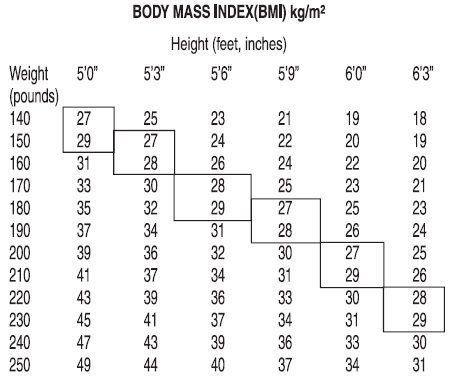
The limited usefulness of agents of this class, including Phentermine hydrochloride, [ see CLINICAL PHARMACOLOGY ( 12.1, 12.2)] should be measured against possible risk factors inherent in their use such as those described below.
Related/similar drugs
2 DOSAGE AND ADMINISTRATION
2.1 Exogenous Obesity
Dosage should be individualized to obtain an adequate response with the lowest effective dose.
The usual adult dose is 15 mg to 30 mg at approximately 2 hours after breakfast for appetite control. Late evening medication should be avoided because of the possibility of resulting insomnia. Administration of one capsule (30 mg) daily has been found to be adequate in depression of the appetite for 12 to 14 hours.
Phentermine is not recommended for use in patients 16 years of age and under.
Late Evening medication should be avoided because of the possibility of resulting insomnia.
2.2 Dosage in Patients With Renal Impairment
The recommended maximum dosage of phentermine hydrochloride is 15 mg daily for patients with severe renal impairments (eGFR 15 to 29 mL/min/1.73 m 2). Avoid use of phentermine hydrochloride in patients with eGFR less than 15 mL/min/1.73 m 2 or end-stage renal disease requiring dialysis [see Use in Specific Populations ( 8.6) and Clinical Pharmacology ( 12.3)] .
DOSAGE FORMS AND STRENGTHS
Capsules containing 15 mg and 30 mg Phentermine Hydrochloride
CONTRAINDICATIONS
- History of cardiovascular disease (e.g., coronary artery disease, stroke, arrhythmias, congestive heart failure, uncontrolled hypertension)
- During or within 14 days following the administration of monoamine oxidase inhibitors
- Hyperthyroidism
- Glaucoma
- Agitated states
- History of drug abuse
- Pregnancy [see Use in Specific Populations ( 8.1)]
- Nursing [see Use in Specific Populations ( 8.3)]
- Known hypersensitivity, or idiosyncrasy to the sympathomimetic amines
Warnings and Precautions
5.1 Coadministration with Other Drug Products for Weight Loss
Phentermine is indicated only as short-term (a few weeks) monotherapy for the management of exogenous obesity. The safety and efficacy of combination therapy with phentermine and any other drug products for weight loss including prescribed drugs, over-the-counter preparations, and herbal products, or serotonergic agents such as selective serotonin reuptake inhibitors (e.g., fluoxetine, sertraline, fluvoxamine, paroxetine), have not been established. Therefore, coadministration of phentermine and these drug products is not recommended.
5.2 Primary Pulmonary Hypertension
Primary Pulmonary Hypertension (PPH) – a rare, frequently fatal disease of the lungs – has been reported to occur in patients receiving a combination of phentermine with fenfluramine or dexfenfluramine. The possibility of an association between PPH and the use of phentermine alone cannot be ruled out; there have been rare cases of PPH in patients who reportedly have taken phentermine alone. The initial symptom of PPH is usually dyspnea. Other initial symptoms may include angina pectoris, syncope or lower extremity edema. Patients should be advised to report immediately any deterioration in exercise tolerance. Treatment should be discontinued in patients who develop new, unexplained symptoms of dyspnea, angina pectoris, syncope or lower extremity edema, and patients should be evaluated for the possible presence of pulmonary hypertension.
5.3 Valvular Heart Disease
Serious regurgitant cardiac valvular disease, primarily affecting the mitral, aortic and/or tricuspid valves, has been reported in otherwise healthy persons who had taken a combination of phentermine with fenfluramine or dexfenfluramine for weight loss. The possible role of phentermine in the etiology of these valvulopathies has not been established and their course in individuals after the drugs are stopped is not known. The possibility of an association between valvular heart disease and the use of phentermine alone cannot be ruled out; there have been rare cases of valvular heart disease in patients who reportedly have taken phentermine alone.
5.4 Development of Tolerance, Discontinuation in Case of Tolerance
When tolerance to the anorectant effect develops, the recommended dose should not be exceeded in an attempt to increase the effect; rather, the drug should be discontinued.
5.5 Effect on the Ability to Engage in Potentially Hazardous Tasks
Phentermine may impair the ability of the patient to engage in potentially hazardous activities such as operating machinery or driving a motor vehicle; the patient should therefore be cautioned accordingly.
5.6 Risk of Abuse and Dependence
Phentermine is related chemically and pharmacologically to amphetamine (d- and d/l-amphetamine) and other related stimulant drugs have been extensively abused. The possibility of abuse of phentermine should be kept in mind when evaluating the desirability of including a drug as part of a weight reduction program. See Drug Abuse and Dependence ( 9) and Overdosage ( 10) .
The least amount feasible should be prescribed or dispensed at one time in order to minimize the possibility of overdosage.
5.7 Usage with Alcohol
Concomitant use of alcohol with Phentermine may result in an adverse drug reaction.
5.8 Use in Patients with Hypertension
Use caution in prescribing Phentermine for patients with even mild hypertension (risk of increase in blood pressure).
5.9 Use in Patients on Insulin or Oral Hypoglycemic Medications for Diabetes Mellitus
A reduction in insulin or oral hypoglycemic medications in patients with diabetes mellitus may be required.
ADVERSE REACTIONS
The following adverse reactions are described, or described in greater detail, in other sections:
- Primary pulmonary hypertension [ see Warnings and Precautions ( 5.2) ]
- Valvular heart disease [ see Warnings and Precautions ( 5.3) ]
- Effect on the ability to engage in potentially hazardous tasks [ see Warnings and Precautions ( 5.5) ]
- Withdrawal effects following prolonged high dosage administration [ see Drug Abuse and Dependence ( 9.3) ]
The following adverse reactions to phentermine have been identified:
Cardiovascular: Primary pulmonary hypertension and/or regurgitant cardiac valvular disease, palpitation, tachycardia, elevation of blood pressure, ischemic events.
Central Nervous System: Overstimulation, restlessness, dizziness, insomnia, euphoria, dysphoria, tremor, headache, psychosis.
Gastrointestinal: Dryness of the mouth, unpleasant taste, diarrhea, constipation, other gastrointestinal disturbances.
Allergic: Urticaria.
Endocrine: Impotence, changes in libido.
Drug Interactions
7.1 Monoamine Oxidase Inhibitors
Use of Phentermine is contraindicated during or within 14 days following the administration of monoamine oxidase inhibitors because of the risk of hypertensive crisis.
7.2 Alcohol
Concomitant use of alcohol with phentermine may result in an adverse drug reaction.
7.3 Insulin and Oral Hypoglycemic Medications
Requirements may be altered [ see Warnings and Precautions ( 5.9) ].
7.4 Adrenergic Neuron Blocking Drugs
Phentermine may decrease the hypotensive effect of adrenergic neuron blocking drugs.
USE IN SPECIFIC POPULATIONS
8.1 Pregnancy
Pregnancy category X
Phentermine is contraindicated during pregnancy because weight loss offers no potential benefit to a pregnant woman and may result in fetal harm. A minimum weight gain, and no weight loss, is currently recommended for all pregnant women, including those who are already overweight or obese, due to obligatory weight gain that occurs in maternal tissues during pregnancy. Phentermine has pharmacologic activity similar to amphetamine (d- and d/l-amphetamine) [ see Clinical Pharmacology ( 12.1) ]. Animal reproduction studies have not been conducted with phentermine. If this drug is used during pregnancy, or if the patient becomes pregnant while taking this drug, the patient should be apprised of the potential hazard to a fetus.
8.3 Nursing Mothers
It is not known if Phentermine is excreted in human milk; however, other amphetamines are present in human milk. Because of the potential for serious adverse reactions in nursing infants, a decision should be made whether to discontinue nursing or to discontinue the drug, taking into account the importance of the drug to the mother.
8.4 Pediatric Use
Safety and effectiveness in pediatric patients have not been established. Because pediatric obesity is a chronic condition requiring long-term treatment, the use of this product, approved for short-term therapy, is not recommended.
8.5 Geriatric Use
In general, dose selection for an elderly patient should be cautious, usually starting at the low end of the dosing range, reflecting the greater frequency of decreased hepatic, renal, or cardiac function, and of concomitant disease or other drug therapy.
This drug is known to be substantially excreted by the kidney, and the risk of toxic reactions to this drug may be greater in patients with impaired renal function. Because elderly patients are more likely to have decreased renal function, care should be taken in dose selection, and it may be useful to monitor renal function.
8.6 Renal Impairment
Based on the reported excretion of Phentermine in urine, exposure increases can be expected in patients with renal impairment [ see Clinical Pharmacology ( 12.3) ].
Use caution when administering phentermine hydrochloride to patients with renal impairment. In patients with severe renal impairment (eGFR 15 to 29 mL/min/1.73 m 2), limit the dosage of phentermine hydrochloride to 15 mg daily [ see Dosage and Administration ( 2.2) ]. Phentermine hydrochloride has not been studied in patients with eGFR less than 15 mL/min/1.73 m 2, including end-stage renal disease requiring dialysis; avoid use in these populations.
DRUG ABUSE AND DEPENDENCE
9.1 Controlled Substance
Phentermine is a Schedule IV controlled substance.
Phentermine is related chemically and pharmacologically to the amphetamines. Amphetamines and other stimulant drugs have been extensively abused and the possibility of abuse of phentermine should be kept in mind when evaluating the desirability of including a drug as part of a weight reduction program.
Abuse of amphetamines and related drugs may be associated with intense psychological dependence and severe social dysfunction. There are reports of patients who have increased the dosage of these drugs to many times that recommended. Abrupt cessation following prolonged high dosage administration results in extreme fatigue and mental depression; changes are also noted on the sleep EEG. Manifestations of chronic intoxication with anorectic drugs include severe dermatoses, marked insomnia, irritability, hyperactivity and personality changes. A severe manifestation of chronic intoxication is psychosis, often clinically indistinguishable from schizophrenia.
OVERDOSAGE
The least amount feasible should be prescribed or dispensed at one time in order to minimize the possibility of overdosage.
10.1 Acute Overdosage
Manifestations of acute overdosage include restlessness, tremor, hyperreflexia, rapid respiration, confusion, assaultiveness, hallucinations, and panic states. Fatigue and depression usually follow the central stimulation. Cardiovascular effects include tachycardia, arrhythmia, hypertension or hypotension, and circulatory collapse. Gastrointestinal symptoms include nausea, vomiting, diarrhea and abdominal cramps. Overdosage of pharmacologically similar compounds has resulted in fatal poisoning usually terminates in convulsions and coma.
Management of acute phentermine hydrochloride intoxication is largely symptomatic and includes lavage and sedation with a barbiturate. Experience with hemodialysis or peritoneal dialysis is inadequate to permit recommendations in this regard. Acidification of the urine increases phentermine excretion. Intravenous phentolamine (Regitine ®, CIBA) has been suggested on pharmacologic grounds for possible acute, severe hypertension, if this complicates overdosage.
Manifestations of chronic intoxication with anorectic drugs include severe dermatoses, marked insomnia, irritability, hyperactivity and personality changes. The most severe manifestation of chronic intoxications is psychosis, often clinically indistinguishable from schizophrenia. See Drug Abuse and Dependence ( 9.3) .
DESCRIPTION
Phentermine hydrochloride is a sympathomimetic amine anorectic. Its chemical name is α,α,-dimethylphenethylamine hydrochloride. The structural formula is as follows:
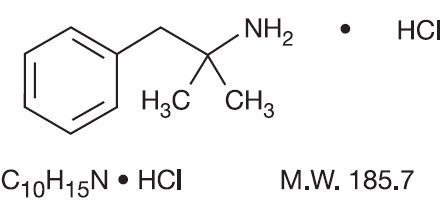
Phentermine Hydrochloride is a white, odorless, hygroscopic, crystalline powder which is soluble in water and lower alcohols, slightly soluble in chloroform and insoluble in ether.
Phentermine hydrochloride is available as:
a) powder-filled capsules containing 15 mg Phentermine hydrochloride (equivalent to 12 mg Phentermine) or 30 mg Phentermine hydrochloride (equivalent to 24 mg Phentermine) and inactive ingredients: corn starch, gelatin, lactose monohydrate and magnesium stearate. In addition, the 15 mg capsules contain D&C Yellow #10, FD&C Blue #1, FD&C Red #3, FD&C Red #40, titanium dioxide and the 30 mg capsules contain D&C Yellow #10, FD&C Red #3, titanium dioxide.
b) bead-filled capsules containing 30 mg Phentermine hydrochloride (equivalent to 24 mg Phentermine) and inactive ingredients: corn starch, sucrose, hypromellose, povidone, and talc. In addition, the capsule contains FD&C blue #1/Brilliant blue FCF Aluminum Lake, D&C red #28 and gelatin.
Phentermine Capsules – Clinical Pharmacology
12.1 Mechanism of Action
Phentermine is a sympathomimetic amine with pharmacologic activity similar to the prototype drugs of this class used in obesity, amphetamine (d- and dll-amphetamine). Drugs of this class used in obesity are commonly known as “anorectics” or “anorexigenics.” It has not been established that the primary action of such drugs in treating obesity is one of appetite suppression since other central nervous system actions, or metabolic effects, may also be involved.
Typical actions of amphetamines include central nervous system stimulation and elevation of blood pressure. Tachyphylaxis and tolerance have been demonstrated with all drugs of this class in which these phenomena have been looked for.
| Pills Quantity | 60 Pills, 120 Pills, 180 Pills, 240 Pills, 300 Pills |
|---|

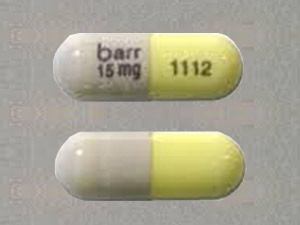
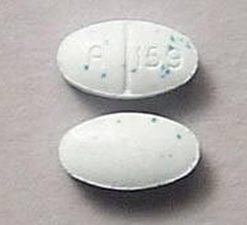
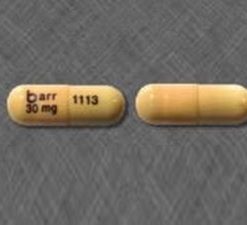
Reviews
There are no reviews yet.